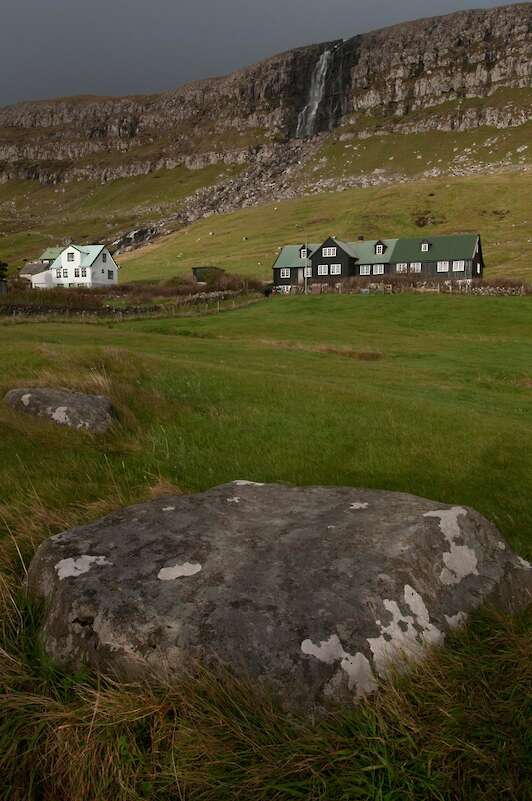Site Overview
See where the Faroe Island's only coin hoard was discovered
The parish church at Sandur in the south of Sandoy, built in 1839, is a good example of an old Faroese wooden church with black walls, turf roof and white belfry. Archaeological excavations have revealed extensive remains of settlement, including an important series of five former churches, the earliest being associated with an 11th-century coin hoard.
Sandur Hoard
The Sandur hoard was found 1863 and consists of 98 silver coins, probably buried between 1070 and 1080. The hoard is the oldest and only coin hoard found in the Faroe Islands. The hoard indicates with which countries the Faroese traded in the 11th century. Today the coins are located at the National Museum of the Faroe Islands.
Excavations
The oldest church was a small stave-church of similar type found in Norway in the 11th century. Twenty-six graves and 42 mainly Norwegian coins from the 13th century were discovered in layers of the second oldest building. Excavations within the churchyard uncovered part of a Viking longhouse with curved walls and a beautiful floor set with large flat flagstones. Further excavations during the extension of the burial ground revealed 12 Viking graves of men and women of some substance: the grave goods included silver rings, knives, a bronze Irish-style ornament, a string of pearls and a Kufic Arab coin, dating to 750-775 – the only one of its kind in the Faroe Islands.
Further nearby excavations at Junkarinsfløttur have revealed a significant farm dating from the 9th century to 1200. Evidence of the way of life can be pieced together from the locally-made earthenware, imported soapstone pots, ironware, bird and animal bones, and a 10th-century decorated bronze brooch.
 Thing Districts
Thing Districts
As well as the main thing held in Tórshavn at high summer, Faroe was divided into six thing districts: Suðuroy, Sandoy, Vágoy, Streymoy, Eysturoy and Norðuroyar, and meetings took place here in the spring, although there is one reference to an autumn thing.
The district things were lower courts and cases could be transferred to the althing, or løgthing, but this was not always done, and several sentences, even involving corporal punishment, along with death sentences, were passed and carried out at a district thing. Places of execution are therefore part of most district thingsteads.
Sandoy Thing
The thing district of Sandoy covered the islands of Sandoy, Skúvoy and Dímun. The thing met on the farm í Trøðum in the village heima á Sandi, where a stone bearing the name Tingborði (the thing table) is still located. Further east the ancient thingstead is said to have been at millum Vatna, the area between the two small lakes.
Sigmundur Brestisson
The Viking chieftain, Sigmundur Brestisson, who brought Christianity to the Faroe Islands around 1000, is buried at Olansgardur on the neighbouring island of Skúvoy. He lived on the island and, according to Faroese sagas, went into the sea from the cliffs at Skúvoy to escape an onslaught led by his arch rival, the chieftain Tróndur í Gøta.
There is a large tombstone with a carved cross called Sigmundarsteinur in the churchyard. Eleven cross slabs carved with Latin and Celtic crosses, similar to ones found in the Western Isles of Scotland and Ireland, are now preserved in the National Museum of the Faroe Islands.
Contact Details
Address
Visit Faroe Islands, Bryggjubakki, P.O. Box 118, FO-110 Tórshavn
Website URL
www.visitfaroeislands.comLoadingPlease Wait
Key Attractions
- Village
- Religion and Belief
- Viking Trails
- Famous Vikings
- Excavations




